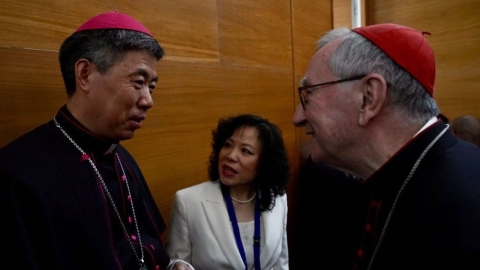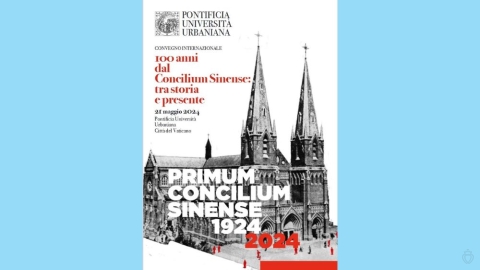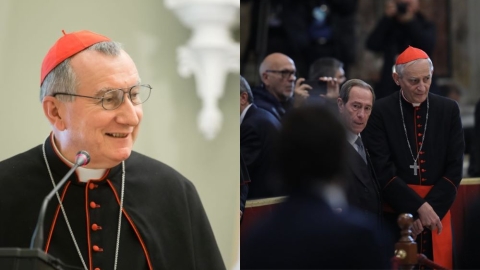Vatican: Francis Wants to Make the Church “Less Masculine”

Mother Church, represented in a Vatican manuscript. The Church is surrounded by clerics on the left and laity on the right.
On Thursday, November 20, 2023, on the feast of St. Andrew, Pope Francis received the members of the International Theological Commission. He had prepared a speech which he was unable to read due to his illness, and which was given to the participants.
In the preamble, the Pope encourages the theologians present. Then he adds: “But there is something about you that I do not like; pardon my sincerity.” According to the report, he continued: “One, two, three, four women: poor women! … We must advance in this.” And he added that “women have a capacity for theological reflection that is different to that of us men.”
The Pope then added that “if we do not know what a woman is, what the theology of a woman is, we will never understand what Church is.” He then affirmed that “one of the great sins we have had is to ‘masculinize’ the Church.” He concluded: “Please make the Church less masculine.”
Confused and Erroneous Thinking
It must be emphasized that the Fathers of the Church, of whom it would be astonishing to say that they did not know what the Church was, did not know a “theology of a woman.” There have been, throughout the history of the Church, writings of solid theology given by women. Let us think of Sts. Teresa of Avila, Catherine of Siena, and Hildegard, but they do not go back to a distant period.
As for this “great sin” of the masculinization of the Church, what does it represent in the Pope’s thinking? Does he mean only theologians considered the Church as too masculine? After all, title “Bride of Christ” goes back to St. Paul himself (Ephesians 5). The assimilation between the Church and the Virgin Mary can also be given as an example of the femininity attributed at all times to the Church. And the presence of the Mother of God at the Cross, while the Church was springing up from the pierced side of the Savior, is another confirmation of this always believed, affirmed, and lived truth.
So in what sense should we interpret this “great sin”? A passage from Francis’s speech states, “[Hans Urs von] Balthasar’s thought has brought me so much light: Petrine principle and Marian principle. These can be debated, but the two principles are there. The Marian is more important than the Petrine, because there is the bride Church, the woman Church, without being masculine.”
The opposition, or at least the distinction, between the two principles, Petrine and Marian, and the affirmation that the second is the more important, seems to insinuate that the past has placed too much emphasis on the first to the detriment of the second. Could this be the masculinization that the Pope wants to talk about? This would demonstrate an ignorance that can hardly be attributed to the Holy Father.
How, in fact, can he ignore the development of Marian dogma and the devotion to the Mother of God among Christian peoples, who have left so many tangible proofs, such as the magnificent churches dedicated to the Virgin Mary, as well as all the theological treatises or spiritual works dedicated to her?
A Disjunction of Powers Contrary to Revelation
There remains one way of understanding the Pope's assertion: this “great sin” resides in the exclusivity given to men in the hierarchy of the Church and in ecclesiastical jurisdiction. And this is undoubtedly where we must look for this terrible fault according to the successor of Peter.
Moreover, the systematic policy of the feminization of the curia, led by Francis for years, appears to be a “reparation” for this sin and this error. But then we find ourselves in opposition to the doctrine of the Church and of Christ, of which the Pope is the vicar.
If Francis recognizes that the sacrament of orders can only be given to men, he cannot, without being illogical, want to entrust jurisdiction to women. Yet this is what he is trying to do with the constitution Praedicate evangelium, by which he reformed the curia.
But wanting to do something does not mean that it is possible. It should also be noted that this disjunction is contrary to the very letter of the Second Vatican Council in Lumen Gentium. Whatever one thinks of this last text, there is quite simply an internal contradiction, which Cardinal Gerhard Müller did not fail to point out, and which an FSSPX.News article highlighted (cf. the linked article).
Conclusion
To try to clarify the error, let us note that we need to distinguish between several aspects of the Church. The “feminine” aspect, which is part of revelation, distinguishes it from Christ while uniting it to Him. It concerns the sanctification of souls. This fruitful spouse of the Savior communicates grace and education to the children He gives her, as a mother does. In this sense, the Church is fully female.
(Source : vatican.va – FSSPX.Actualités)
Illustration : Domaine public





